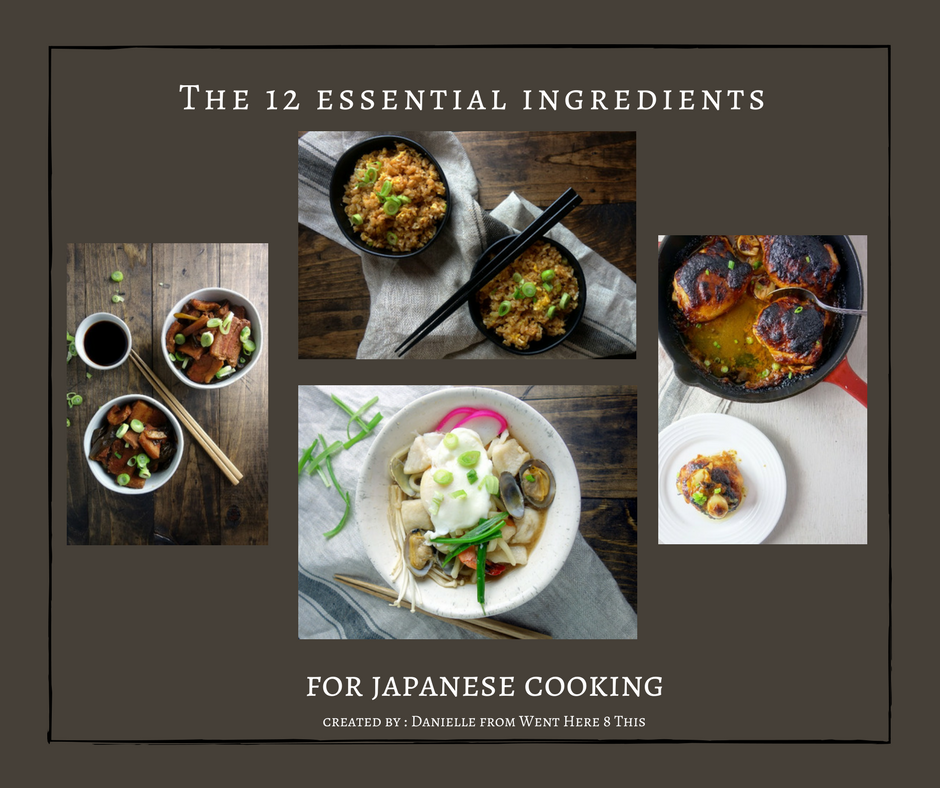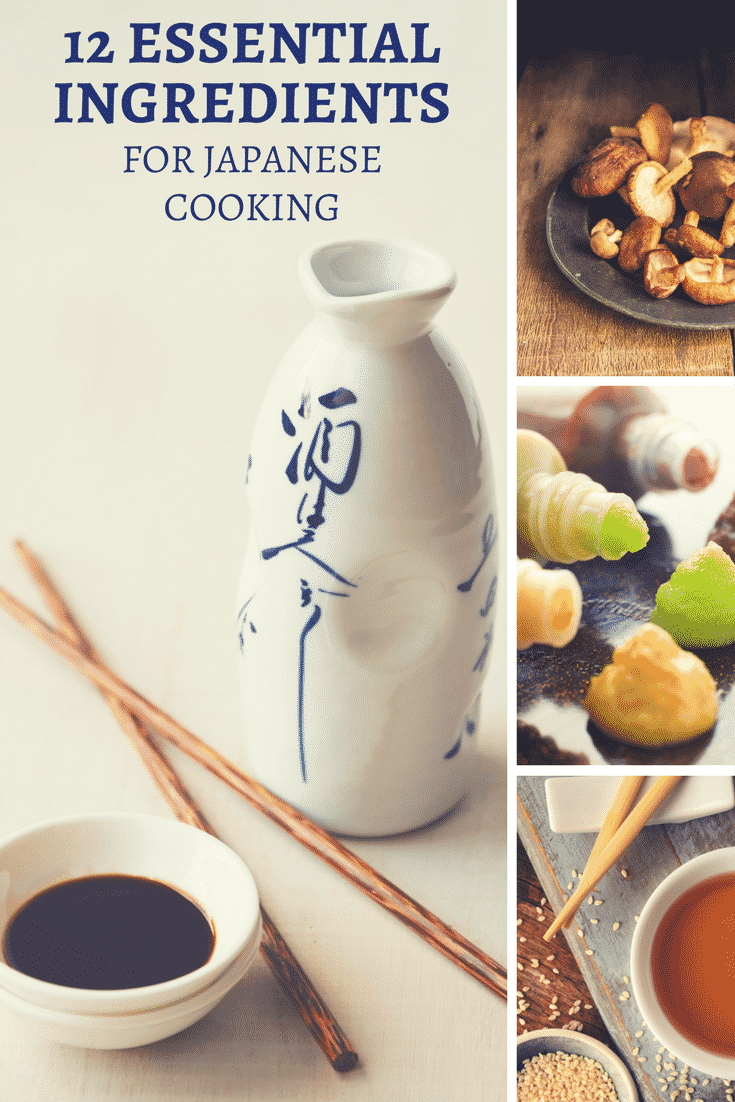This post may contain affiliate links. Please read my disclosure.
Stock your pantry with these 12 essential ingredients for Japanese cooking

This post contains affiliate links.
Hey guys. So Japanese food month is coming up starting January 1.
I am super excited about this. I've been doing some recipe developing and working on the photographs all month in preparation.
As I was working on the recipes, I realized that we should talk a little about the ingredients before we dive in to cooking for the month.
There is a litany of Japanese ingredients you can use in your cooking, but I'm going to go through just the essentials. This covers all the ingredients you will need to make the recipes I will be posting in January.
Japanese food is good stuff guys. If you haven't had much experience with it, now is your chance.
Packed full of delicious umami flavors, braised meats and vegetables, this is one of my absolute favorite cuisines and I can't wait to share these recipes with you.
And as usual, they are not difficult. Well, except maybe the Japanese cheesecake. That takes a little effort. But totally doable and TOTALLY worth it.
Now all of these ingredients can be found either at your local supermarket or Asian grocery store (really depends where you live). However, if it's cold outside and you just don't feel like leaving the house, I've also included Amazon links where you can buy these products. I've included links to my favorite brands, but really any brand will work. Now, I do make a small commission if you buy a product through one of these links. But guys...that helps me keep this blog running!
Jump to:
Want to Save This Recipe?
Enter your email & I'll send it to your inbox. Plus, get great new recipes from me every week!
By submitting this form, you consent to receive emails from Went Here 8 This.
The Essential Japanese Ingredients
Rice Vinegar
Make sure you buy the non-seasoned. The seasoned has more flavor due to the additional of salt, sugar and possibly MSG. Now that's all good if you want to use that as a salad dressing or something of the sort, but we don't want it for cooking. Rice vinegar has a mildly sweet flavor, and is much less acidic than most other Western vinegars (think apple cider). This stuff is good guys. It's almost just drinkable.
Speaking of which, any of you guys on that drinking vinegar band wagon? I tried it and it's actually pretty tasty!
Mirin
Mirin is a rice wine that is similar to sake, but has a much higher sugar content. This is one of my favorite sweetening agents in much my cooking, not just Japanese.
Try this recipe: Chinese Twice Cooked Pork
Sake
Sake is a rice wine made by fermenting rice. There are a million different kinds of sake. I mean seriously, there are so many. Really, any of them work. I recommend using a cheaper version for cooking and save the good stuff for drinking! Sake can typically be found at your local grocery store, or Asian market of course.
Miso Paste
Miso paste is basically fermented soybeans and one of the best umami seasonings with it's salty goodness. It's used a lot in soups, but also salad dressings and sauce (stay tuned for my Miso Butter Chicken). I recommend buying white miso paste as it will be more versatile. Don't get me wrong, red miso is quite tasty, but if we're talking basic pantry items here, go with the white as it tends to be more versatile.
Soy Sauce
Another ingredient made from fermented soybeans, soy sauce has become a staple in many American households. I put it on everything I can. Seriously, I actually used to put it on frozen burritos....yes, I occasionally eat frozen burritos.
There are many different kinds of soy sauce; I keep a dark mushroom soy sauce and a light soy sauce that tends to be just a bit saltier. And there is this soy sauce for seafood that is the s**t. It's sooooo good guys.
But for just basic cooking, your good old Kikkoman soy sauce will work just fine.
Try this recipe: Japanese Beef Curry Udon
Ponzu Sauce
Ponzu sauce is a tangy soy-based sauce. You see a theme here? Japanese cooking uses a lot of fermented soy based products. Perhaps that is why it is so incredibly flavorful. I love it.
Typically made with citrus, ponzu sauce has a wonderfully tart flavor. You can buy it or make it from scratch; Nami from Just One Cookbook has a great recipe for Ponzu Sauce.
Shiitake Mushrooms
I love shiitake mushrooms both for their hearty, delicious flavor, but also because they come dried and can be stored in your cabinets for months. When I buy fresh mushrooms, they start going bad in a day or so. Shiitake mushrooms are a staple in many Asian diets and apparently are quite good for you.
Panko Bread Crumbs
Light, flaky breadcrumbs, typically made out of white bread. Because of the light, airy quality, panko bread crumbs crisp easier when cooking. I use panko breadcrumbs in place of regular breadcrumbs for most of my cooking.
Try this recipe: Crispy Panko Crusted Pork Chops with Onion Gravy
Wasabi
Wasabi is like Japanese horseradish. Most of what we have in Japanese restaurants is horseradish used as a substitute due to the scarcity of the actual wasabi plant. Now, the higher end restaurants will serve real wasabi, and you can really tell the difference. It's not as harsh as the stuff served in your run of the mill sushi joint.
This wasabi paste works great for any recipe.
Dashi Powder
Another favorite ingredient of mine. Dashi is a soup stock typically made with dried bonito flakes, kelp, and/or small dried sardines. Used as a base in many Japanese soups, dashi packs a pretty amazing umami flavor. Now you can make your own Dashi stock (it's pretty easy), but as you guys already know, I'm kinda lazy. So I buy the powder to save some time. If you'd like to make your own, check out this post by Nami at Just One Cookbook.
Togarashi
Basically ground chili peppers. It also typically includes black pepper, seaweed flakes, sesame seeds and dried orange peels for a slightly citrusy taste. Great as a condiment served on soups, noodles dishes, and yakitori.
Sesame Oil
I have been cooking with sesame oil for what feels like centuries. A small amount goes a long way when dealing with sesame oil, but the flavor is delicious.
Try this recipe: Home Made Japanese Curry Roux
And there you have it. You're ready to start cooking with these 12 essential ingredients for Japanese cooking!

Love making Japanese food? I'd love to hear about your favorite dishes to make in the comments!






Alex Turner
I really found it quite helpful. I love the shiitake mushrooms.These are nutritional powerhouses and I like the garlic sauteed one.I will soon try make something amazing with these other ingridents..:D
Danielle@wenthere8this
Shiitake's are awesome! I love using them for their unique flavor. I hope you are able to make use of these ingredients.